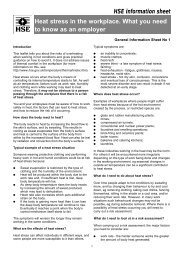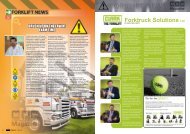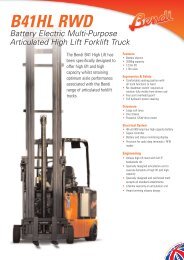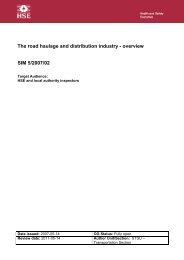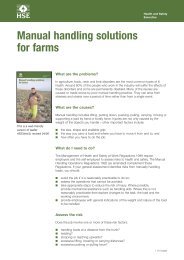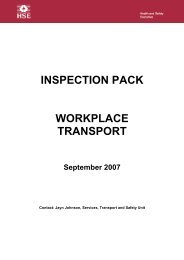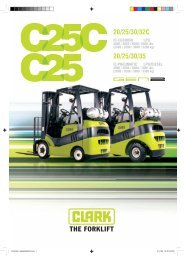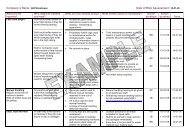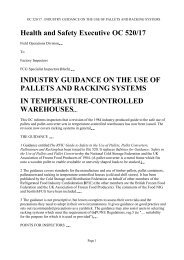SRAG - Chemical Warehouses Version 6 26 June 2002Metamitron (nitrogen containing) 600m NO2DD NO20.154.2.6 Other methods of predicting a toxic hazard rangeAssessors are likely to see several other approaches used in COMAH safety reports including: -1. Toxic substances are converted to equivalent quantities of the most toxic by multiplying by thetoxicity ratio.2. The mass of the most toxic substance in the warehouse is assumed to be equal to the totalmass of toxics.3. More than 10% of the most dangerous inventory (product of mass and toxicity) over the pastthree years is assumed to be released over 30 minutes into a passive smoke plume.All of these approaches introduce an acceptable amount of conservatism into the hazard rangecalculation, which Assessors need to balance against optimism incorporated in other parts of theconsequence analysis.4.2.6.1 Use of the Average PesticideThere is a school of thought which believes that it will never be possible to build mathematical modelsto accurately predict the hazards from a burning pesticide warehouse that contains a large number ofsubstances in different chemical and physical form and packaging arrangements. This schooltherefore recommends that the hazard analysis is based on a hypothetical "average" agrochemicalwhich releases a variety of low molecular weight toxic gases when burnt. The composition of theaverage agrochemical is determined from the molecular composition and masses of differentsubstances in the warehouses. The example shown in the table below illustrates how to calculaterelease rates of the different gases.Table 8 shows how the composition of the average agrochemical can be determined from theinventory of three agrochemicalsis: -C 8.8 H 10.9 Cl 1.54 S 1.5 N 1 O 2.1The average molecular weight is 267 and if the burning rate of material in the warehouse was 20kg/s,then 74.8mols/s would be combusted. From this the rate of release of different products is:-HCl 4.2kg/s.SO 2 7.2.NO 2 0.17.HCN 0.1.CO 19.7.A hazard range based of the addition of fractional dangerous doses is then likely to be conservativeunless the warehouse contains very large quantities of an extremely toxic substance such as phorate.Table 8: Calculation of a representative substance for an agrochemicalwarehouseQuantity50,00020,00040,000Mol.Weight322.5296.6380.5CompositionC7H7Cl3NO3PSC9H4Cl3NO2SC20H32N2O3SNo. of kgatomsCarbon1,085606.92,102.53,794.48.8No. of kgatomshydrogen1,0852,6983,3644,71910.9No. of kgatomschlorine46520206671.54No. of kgatomssulphur310134.82106551.51No. of kgatomsnitrogen15567.5210432.51No. of kgatomsoxygen465138315.59152.15 EXPLOSIONS IN WAREHOUSESSome substances are referred to as explosive because under certain conditions they are liable toundergo a rapid chemical reaction which produces large quantities of hot gas. There is not a precise
SRAG - Chemical Warehouses Version 6 26 June 2002definition of the term explosive, but the three most important characteristics of explosives are thespeed of the transformation to gas, the quantity of gas produced and the temperature of the gas.Unfortunately there are two distinct types of explosion which are referred to as deflagration anddetonation and these tend to be confused in the literature on account of the fact that the effects ofdeflagration and detonations are not always a clear guide to the nature of the explosion. Thedestructive effects of a deflagration can occasionally be comparable to those of a detonation, but ingeneral the characteristics of the two phenomena are rather different.5.1 Deflagration and thermal propertiesDuring a deflagration, the chemical reaction zone travels from one particle of the substance to anotherby thermal conduction and convection; therefore, the physical state of the substance has a markedeffect on its explosive power. The velocity of the deflagration front in a solid in the open air is quitedifferent from that in a solid contained in a closed vessel, because the velocity of reaction frontincreases with the pressure exerted on the solid by the combustion gases. Thus, in a closed containerthe deflagration front accelerates as pressure increases, but rarely exceeds 1m/s.The strength of the container governs the maximum pressure rise, and hence the maximum speedand duration of the deflagration, which in turn governs the maximum air pressure generated by theexplosion. Containment of explosives should therefore be avoided wherever possible. If this is notpossible containers should be open or of low strength and should not be stacked high because thisincreases the confinement of the central and lower layers.The characteristics of condensed explosive fall into two main groups the first of which containschemical information such as composition and heat of formation at constant volume. The secondgroup includes the physical properties of the substance and the conditions under which it is stored(exploded). The first group, together with the quantity, determines the consequences of an explosionshould one occur, while the second relates to the probability of an explosion and hence the safety ofthe storage arrangements.5.2 Explosive yieldSince an explosion is the rapid conversion of a solid into a gas at high temperature, the basicparameters governing explosive yield are the quantity of gas produced and the heat released by thereaction, which determines the maximum temperature reached.The quantity of gas produced is usually expressed as a volume at 0 o C and 1 atmosphere pressure per1kg of the explosive. It is denoted by V o and is calculated from the chemical equation representing theexplosive reaction, treating the gases as ideal gases.The heat of the explosion is the quantity of heat released during the decomposition. It is determined bythe chemical equation representing the explosion reaction in which the explosive products on the righthand side are in a physical state appropriate to the high pressure and temperature conditions of theexplosion. Any water formed is in the vapour state. The heat of an explosion, measured per unit massof explosive, is designated Q v and is closely approximated by the heat of reaction; however, there isnot a unique way of determining Q v and different thermodynamic relations yield different results.There is little point in striving for high accuracy in a calculation of explosive yield because not only isthe final thermodynamic state of the products uncertain, but the physical state of the containment,storage conditions etc. can have a marked effect on the energy released.Calculation and experiment have determined the energy of explosion of most common explosives, butin practice not all of the energy which could theoretically be released is actually converted into a blastwave. There are numerous reasons for this, but the main one is that only a fraction of the mass of theexplosive actually explodes - the rest is dispersed. The ratio of actual energy released to thattheoretically available is usually referred to as the explosion efficiency.The energy released by an explosion is therefore the product of the mass of the explosive, the energyof explosion of 1kg of the substance and the explosion efficiency. The specific explosion energy isusually measured in terms of the energy of detonation of TNT and is referred to as explosive power: -



